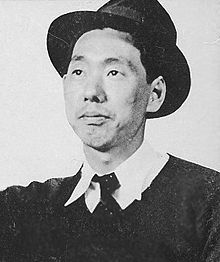Mikio Naruse
| Mikio Naruse | |
|---|---|

Naruse in 1933
|
|
| Born |
August 20, 1905 Tokyo, Japan |
| Died | July 2, 1969 (aged 63) Tokyo, Japan |
| Occupation | Film director, writer and producer |
| Years active | 1930–1967 |
Mikio Naruse (成瀬 巳喜男 Naruse Mikio?, August 20, 1905 – July 2, 1969) was a Japanese filmmaker, screenwriter, and producer who directed some 89 films spanning the period 1930 (towards the end of the silent period in Japan) to 1967.
Naruse is known for imbuing his films with a bleak and pessimistic outlook. He made primarily shomin-geki (working-class drama) films with female protagonists, portrayed by actresses such as Hideko Takamine, Kinuyo Tanaka, and Setsuko Hara. Because of his focus on family drama and the intersection of traditional and modern Japanese culture, his films are frequently compared with the works of Yasujirō Ozu. His reputation is just behind Akira Kurosawa, Kenji Mizoguchi, and Ozu in Japan and internationally; his work remains less well known outside Japan than theirs.
Among Naruse's most revered films are Late Chrysanthemums (1954), Floating Clouds (1955), and When a Woman Ascends the Stairs (1960). Akira Kurosawa called Naruse's style of melodrama, "like a great river with a calm surface and a raging current in its depths".
Mikio Naruse was born in Tokyo in 1905. For a number of years he worked at the Shochiku film company under Shiro Kido as a property manager and later as an assistant director. He was not permitted to direct a film at Shochiku until 1930, when he made his debut film, Mr. and Mrs. Swordplay (Chanbara fūfū).
Naruse's earliest extant work is Flunky, Work Hard (Koshiben gambare, also known as Little Man Do Your Best) from 1931, where he combined melodrama with slapstick, trying to meet the demands set by Shochiku's Kamata studio, who wanted a mix of laughter and tears. In 1933, he quit Shochiku, and began working for Photo-Chemical Laboratories (later known as Toho).
...
Wikipedia
